Related Research Articles

The Bristol Buckmaster was an advanced British training aircraft operated by the Royal Air Force during the 1950s.

The Airco DH.6 was a British military trainer biplane used by the Royal Flying Corps during the First World War. Known by various nicknames, including the "Clutching hand" and "Skyhook", many survived to be used as a civil light aircraft in the postwar era.
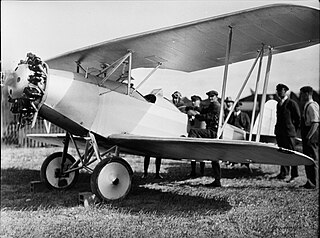
The ASJA L2 was a Swedish biplane trainer aircraft built for the Swedish Air Force in the early 1930s. It was designated Ö 9 in that service. The fuselage was of fabric-covered, welded steel tube construction and accommodated the pilot and instructor in tandem open cockpits. The wings were fabric-covered wood and were of staggered, single bay layout.
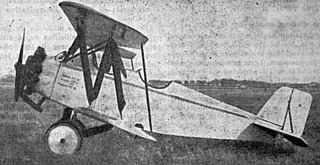
The Albatros L 68 Alauda was a two-seat German trainer aircraft of the 1920s. It was a single-engine biplane of conventional configuration that seated the pilot and instructor in tandem, open cockpits. The wings were of unequal span and had a pronounced stagger.
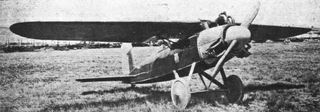
The Albatros L 69 was a two-seat German parasol monoplane racing and training aircraft of 1925. It was a single-engine parasol-wing monoplane of conventional configuration that seated the pilot and passenger in tandem, open cockpits. It was advertised as a trainer, however contemporary reports dismissed this due to the difficulty in accessing the front cockpit, and the designers' focus on performance.
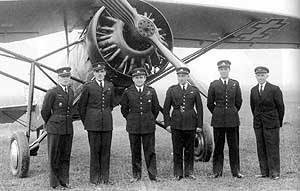
The ANBO V was a parasol wing monoplane training aircraft designed for the Lithuanian Army in 1931. A developed version, the ANBO 51 followed in 1938.
The Avia BH-20 was a civil trainer aircraft built in Czechoslovakia in 1924. It was a single-bay, unstaggered biplane of conventional configuration. The wings were braced with N-struts at around half-span. The pilot and instructor were seated in tandem, open cockpits.

The Fairchild AT-21 was an American World War II specialized bomber crew trainer, intended to train crews in the use of power gun turrets or a gun on a flexible mount, as well as learn to function as a member of a crew. It had a brief career as a training aircraft before modified bombers took over this role.
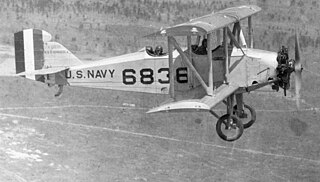
The Boeing NB was a primary training aircraft developed for the United States Navy in 1923. It was a two-bay, equal-span biplane of conventional configuration with interchangeable wheeled and float undercarriage. The pilot and instructor sat in tandem, open cockpits.
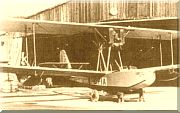
The CANT 7 was a flying boat and training aircraft that was produced in Italy in the 1920s. It was a conventional biplane design with single-bay, unstaggered wings of equal span, with the single engine mounted below the upper wing. The aircraft was designed to prepare pilots for flying boat airliners, and most of the examples produced were purchased by Società Italiana Servizi Aerei for this purpose.
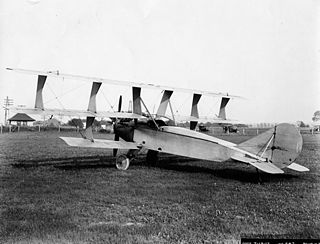
The Curtiss Model L was a triplane trainer aircraft in the United States in 1916 by the Curtiss Aeroplane Company of Hammondsport, New York.

The Fokker S.IX was a military trainer aircraft produced in the Netherlands in the mid-1930s, designed at a Royal Netherlands Navy request for a machine to replace the obsolete Fokker S.IIIs then in service. It was a conventional, single-bay biplane with staggered wings of unequal span braced with N-struts. The pilot and instructor sat in tandem, open cockpits and the undercarriage was of fixed, tailskid type with divided main units. The wing had a wooden structure, the fuselage one of welded steel tube, and the entire aircraft was fabric-covered.
The Maestranza Central de Aviación HF XX-02 was a military trainer aircraft developed in Chile in the 1950s.
The Grahame White Type XV was a military trainer biplane produced in the United Kingdom before and during World War I. It is often referred to as the Box-kite, although this name more properly describes the Grahame-White Type XII, an earlier aircraft made by the company, from which the Type XV was derived. It is also known as the Admiralty Type 1600, since the first aircraft of the type purchased for the Royal Naval Air Service was given that serial number, and contemporary practice was to assign type numbers based on the serial number of the first example in service.

The Hanriot HD.19 was a military trainer aircraft produced in France in the 1920s. Part of the family of designs that began with the HD.14, it was a two-bay biplane with unstaggered wings of equal span. The pilot and instructor sat in tandem, open cockpits. While the HD.14 and most of its derivatives were powered by rotary or radial engines, the HD.19 had a Hispano-Suiza Vee-8.

The Hanriot HD.28 was a military trainer aircraft developed in France in the 1920s as a modernised version of the HD.14 for export markets. The principal difference between the types was that while the HD.14 had an entirely wooden structure, the HD.28's structure was almost entirely of metal. The landing gear was also of more conventional design, with only one wheel on each main unit, plus small anti-noseover skids. The two tandem cockpits of the HD.14 were replaced by a single, long cockpit in which both pilot and instructor sat.
Imperial German Navy seaplanes numbers 1105 to 1106 were the only two examples of a unique design produced for the navy's flying service during the First World War. They were unarmed biplanes of conventional configuration with staggered wings of unequal span. The empennage included a sizable ventral fin. Intended as training aircraft, the pilot and instructor sat in tandem, open cockpits. The undercarriage consisted of twin pontoons. The interplane strut arrangement was remarkable for its day, consisting of N-struts and V-struts without any rigging wires.

Imperial German Navy seaplanes 463 to 466 were a unique seaplane design produced for the Navy's flying service during the First World War. The seaplane base at Kiel-Holtenau ordered the type as a training aircraft in 1915, and the Navy allocated a batch of four serial numbers to the design. No 463 and its siblings were conventional, two-bay biplanes with unstaggered wings of equal span and two open cockpits in tandem for the pilot and instructor. The undercarriage consisted of twin pontoons. The large, square rudder was hinged to the rear end of the fuselage, and extended below the ventral line of the fuselage. The inline engine was neatly cowled in, with the exhaust being collected together in a single stack that extended above the upper wing.

The Praga BH-41, later redesignated E-41, was a military advanced trainer aircraft produced in Czechoslovakia during the 1930s.

The SABCA S.40 was a military trainer aircraft built in Belgium in 1939. It was a graceful, low-wing cantilever monoplane of conventional design with fixed, tailwheel undercarriage. The pilot and instructor sat in tandem cockpits, enclosed by sliding canopies. A single engine driving a two-blade propeller was mounted in the nose. The main undercarriage units were fully independent, mounted under the wings, and enclosed in spats. A small number were built for the Belgian military before the German invasion in 1940.
References
- The Illustrated Encyclopedia of Aircraft. London: Aerospace Publishing. p. 2174.
- Taylor, Michael J. H. (1989). Jane's Encyclopedia of Aviation. London: Studio Editions. p. 511.